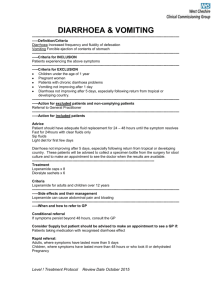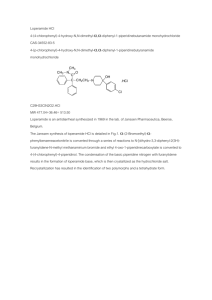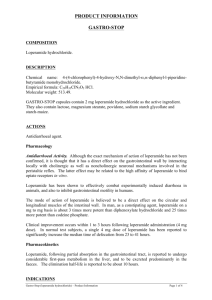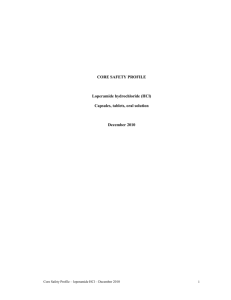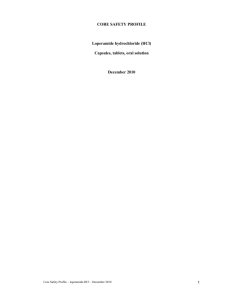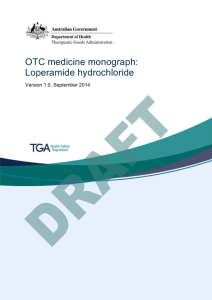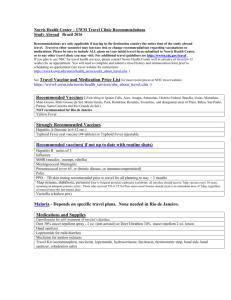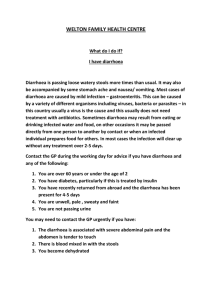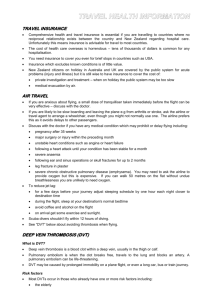Lopacut film-coated tablet ENG SmPC
advertisement
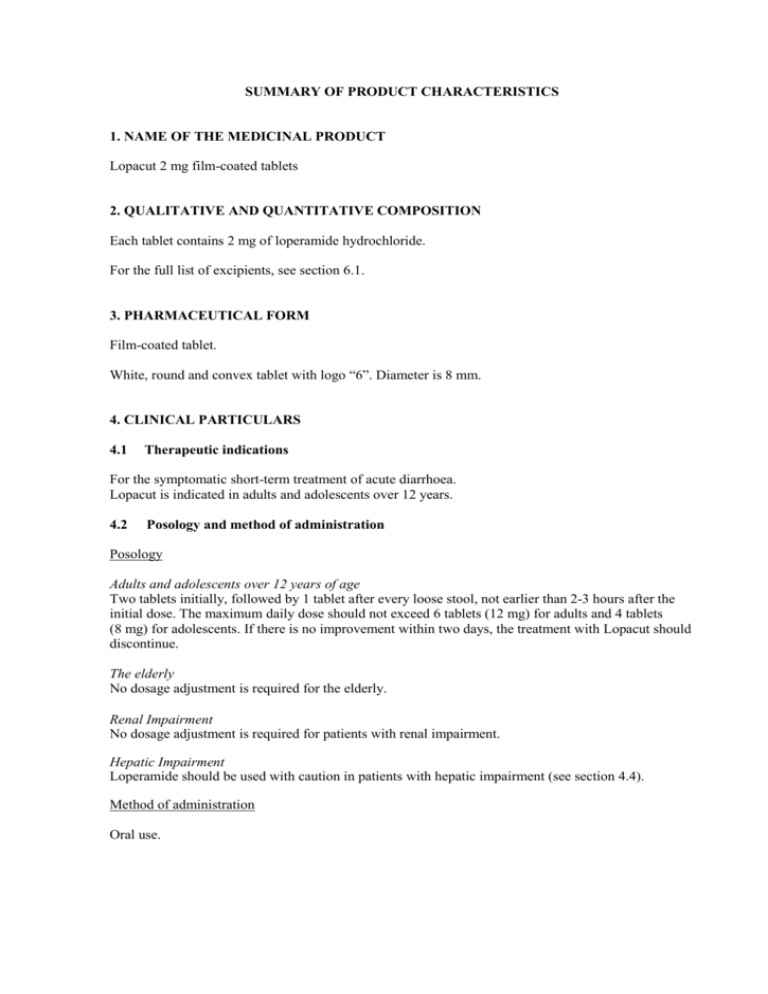
SUMMARY OF PRODUCT CHARACTERISTICS 1. NAME OF THE MEDICINAL PRODUCT Lopacut 2 mg film-coated tablets 2. QUALITATIVE AND QUANTITATIVE COMPOSITION Each tablet contains 2 mg of loperamide hydrochloride. For the full list of excipients, see section 6.1. 3. PHARMACEUTICAL FORM Film-coated tablet. White, round and convex tablet with logo “6”. Diameter is 8 mm. 4. CLINICAL PARTICULARS 4.1 Therapeutic indications For the symptomatic short-term treatment of acute diarrhoea. Lopacut is indicated in adults and adolescents over 12 years. 4.2 Posology and method of administration Posology Adults and adolescents over 12 years of age Two tablets initially, followed by 1 tablet after every loose stool, not earlier than 2-3 hours after the initial dose. The maximum daily dose should not exceed 6 tablets (12 mg) for adults and 4 tablets (8 mg) for adolescents. If there is no improvement within two days, the treatment with Lopacut should discontinue. The elderly No dosage adjustment is required for the elderly. Renal Impairment No dosage adjustment is required for patients with renal impairment. Hepatic Impairment Loperamide should be used with caution in patients with hepatic impairment (see section 4.4). Method of administration Oral use. 4.3 Contraindications Hypersensitivity to the active substance or to any of the excipients listed in section 6.1. Age under 12 years. Loperamide should not be used as the primary therapy in patients with: Acute dysentery, characterised by blood in stools and a high fever. Acute ulcerative colitis or pseudomembranous colitis associated with the use of broadspectrum antibiotic treatment. Bacterial enterocolitis caused by invasive organisms including Salmonella, Shigella, and Campylobacter. When inhibition of peristalsis should be avoided, because of risk of significant sequels including ileus, megacolon or toxic megacolon. Chronic diarrhoea Loperamide must be discontinued promptly when constipation, abdominal distension or ileus develop. 4.4 Special warnings and precautions for use In chronic inflammatory bowel diseases loperamide may mask the symptoms of acute deterioration. The priority in acute diarrhoea is the prevention or reversal of fluid and electrolyte depletion. This is particularly important in children and in frail and elderly patients with acute diarrhoea. In such cases administration of appropriate fluid and electrolyte replacement therapy is the most important measure. The treatment of diarrhea with loperamide is symptomatic only. If specific underlying causes of diarrhoea can be identified, specific treatment should be given when appropriate. In acute diarrhea, if clinical improvement is not observed within 48 hours, the administration of loperamide should be discontinued and patients should be advised to consult their physician. Since persistent diarrhoea can be an indicator of potentially more serious conditions, loperamide should not be used for prolonged periods until the underlying cause of the diarrhoea has been investigated. Although no pharmacokinetic data are available in patients with hepatic impairment, loperamide must be used with caution in such patients because of reduced first pass metabolism. This medicine must be used with caution in patients with hepatic impairment as it may result in a relative overdose leading to CNS toxicity. Patients with AIDS treated with loperamide for diarrhoea should have therapy stopped at the earliest signs of abdominal distension. There have been isolated reports of toxic megacolon in AIDS patients with infectious colitis from both viral and bacterial pathogens treated with loperamide hydrochloride. Combination of high dose loperamide and medicinal products that inhibit P-glycoprotein (e.g. quinidine, ritonavir, cyclosporin, verapamil, and some macrolide antibiotics, e.g. erythromycin and clarithromycin) should be performed with caution (see section 4.5). 4.5 Interaction with other medicinal products and other forms of interaction Cholestyramine Concomitant administration of cholestyramine may decrease absorption of loperamide. P-glycoprotein inhibitors Non-clinical studies have shown that loperamide is a substrate for P-glycoprotein, which for example can be found in the blood-brain barrier. Concomitant use of loperamide (16 mg single dose) with quinidine or ritonavir, which are both P-glycoprotein inhibitors, resulted in a 2 to 3-fold increase in loperamide plasma levels. Theoretically, an increased distribution to the CNS could occur as well. The clinical relevance of this pharmacokinetic interaction with P-glycoprotein inhibitors, when loperamide is given at recommended dosages (2 mg, up to 12 mg maximum daily dose), is unknown, but a risk for a centrally decreased sensitivity for carbon dioxide and thereby an effect on respiration cannot be excluded. Combination of high dose loperamide and medicinal products that inhibit Pglycoprotein, e.g. quinidine, ritonavir, cyclosporin, verapamil, and some macrolide antibiotics, e.g. erythromycin and clarithromycin, should be performed with caution. Dose adjustment may be considered. Itraconazole The concomitant administration of loperamide (4 mg single dose) and itraconazole, an inhibitor of CYP3A4 and P-glycoprotein, resulted in a 3 to 4-fold increase in loperamide plasma concentrations. In the same study a CYP2C8 inhibitor, gemfibrozil, increased loperamide by approximately 2-fold. The combination of itraconazole and gemfibrozil resulted in a 4-fold increase in peak plasma levels of loperamide and a 13-fold increase in total plasma exposure. These increases were not associated with central nervous system (CNS) effects as measured by psychomotor tests (i.e., subjective drowsiness and the Digit Symbol Substitution Test). Ketoconazole The concomitant administration of loperamide (16 mg single dose) and ketoconazole, an inhibitor of CYP3A4 and P-glycoprotein, resulted in a 5-fold increase in loperamide plasma concentrations. This increase was not associated with increased pharmacodynamic effects as measured by pupillometry. Desmopressin Concomitant treatment with oral desmopressin resulted in a 3-fold increase of desmopressin plasma concentrations, presumably due to slower gastrointestinal motility. Anticholinergics Anticholinergics slow stomach and bowels emptying and the effect of loperamide may be stronger. It is expected that drugs with similar pharmacological properties may potentiate loperamide’s effect and that drugs that accelerate gastrointestinal transit may decrease its effect. 4.6 Fertility, pregnancy and lactation Pregnancy There is limited amount of clinical data in pregnant women. Studies in rats have shown increased foetal mortality at high doses. Therefore, until further experience is gained, loperamide should be given only after careful consideration during pregnancy. Although there are no indications that loperamide possesses teratogenic or embryotoxic properties, the anticipated therapeutic benefits should be weighed against potential hazards before loperamide is given during pregnancy, especially during the first trimester. Breast-feeding Small amounts of loperamide may appear in human breast milk. Therefore, loperamide HCl is not recommended during breast-feeding. 4.7 Effects on ability to drive and use machines Tiredness, dizziness and drowsiness may occur in the setting of diarrheal syndromes treated with Lopacut. Therefore, it is advisable to use caution when driving car or operating machinery (see section 4.8). 4.8 Undesirable effects Adults and children aged ≥12 years The safety of loperamide HCl was evaluated in 3076 adults and children aged ≥12 years who participated in 31 controlled and uncontrolled clinical trials of loperamide HCl used for the treatment of diarrhoea. Of these, 26 trials were in acute diarrhoea (N=2755) and 5 trials were in chronic diarrhoea (N=321). The most commonly reported (i.e., ≥1% incidence) adverse drug reactions (ADRs) in clinical trials with loperamide HCl in acute diarrhoea were: constipation (2.7%), flatulence (1.7%), headache (1.2%) and nausea (1.1%). In clinical trials in chronic diarrhoea, the most commonly reported (i.e., ≥1% incidence) ADRs were: flatulence (2.8%), constipation (2.2%), nausea (1.2%) and dizziness (1.2%). The frequency classification of adverse effects is following: Very common (≥ 1/10), Common (≥ 1/100 to < 1/10), Uncommon (≥ 1/1 000 to < 1/100), Rare (≥ 1/10 000 to < 1/1 000), Very rare (< 1/10 000), Not known (can not be estimated from the available data) The following undesirable effects have been reported in either clinical trials or post-marketing experience with loperamide: Immune system disorders: rare: Psychiatric disorders: not known: Nervous system disorders: common: uncommon: rare: Eye disorders: rare: Gastrointestinal disorders: common: uncommon: rare: allergic reaction/hypersensitivity reactiona and in some cases severe hypersensitivity reactions including anaphylactic reaction (including anaphylactic shock) a, anaphylactoid reactiona drowsiness dizziness, headache somnolencea loss of consciousnessa, stupora, decreased level of consciousnessa, hypertoniaa, coordination abnormalitya miosis constipation, nausea, flatulence, abdominal cramping and colic abdominal pain, abdominal discomfort, dryness of mouth, abdominal pain upper, vomiting, dyspepsia ileusa (including paralytic ileus), abdominal distension, megacolona (including toxic megacolonb) Skin and subcutaneous tissue disorders: uncommon: rash rare: urticariaa, pruritusa, angioedemaa, bullous eruptionsa including StevensJohnson Syndrome, erythema multiforme, and toxic epidermal necrolysis Renal and urinary disorders: rare: urinary retentiona General disorders and administration site conditions: rare: fatiguea a: Inclusion of this term is based on post-marketing reports for loperamide HCl. As the process for determining post marketing ADRs did not differentiate between chronic and acute indications or adults and children, the frequency is estimated from all clinical trials with loperamide HCl combined, including trials in children ≤12 years (N=3683). b: See section 4.4 Special warnings and precautions for use. Paediatric population The safety of loperamide HCl was evaluated in 607 patients aged 10 days to 13 years who participated in 13 controlled and uncontrolled clinical trials of loperamide HCl used for the treatment of acute diarrhoea. In general, the ADR profile in this patient population was similar to that seen in clinical trials of loperamide HCl in adults and children aged 12 years and over. Reporting of suspected adverse reactions Reporting suspected adverse reactions after authorisation of the medicinal product is important. It allows continued monitoring of the benefit/risk balance of the medicinal product. Healthcare professionals are asked to report any suspected adverse reactions via the national reporting system listed in Appendix V*. 4.9 Overdose Toxicity: 1-2 mg/day for children 1-6 months of age resulted serious-very serious intoxication. 10 mg for children aged 4 months resulted in very severe intoxication. 3 mg during 16 hours to 4 year old gave moderate intoxication, while 1 mg to 1 ½ year old and maximum of 12 mg to 2 year old (who was treated with gastric lavage) gave mild intoxication. 26 mg to an adult did not give any symptoms after gastric lavage. Symptoms: Symptoms are often delayed and can occur in children after repeated therapeutic doses. In case of overdose (including relative overdose due to hepatic dysfunction), CNS depression (stupor, coordination abnormality, somnolence, miosis, muscular hypertonia, and respiratory depression), urinary retention and ileus may occur. Lethargy, dizziness, confusion, hallucinations, decreased consciousness, coma. Apnea. Increased or decreased muscle tone, opisthotonus. Bradycardia, ventricular extrasystoles. Hyperglycemia. Nausea, vomiting, constipation, and in rare cases, paralytic ileus. Children may be more sensitive to CNS effects than adults. Treatment: If justified gastric lavage, activated charcoal. Monitoring should be extended to 24 hours if a large dose has been taken. If symptoms of overdose occur, naloxone can be given as an antidote. Since the duration of action of loperamide is longer than that of naloxone (1 to 3 hours), repeated treatment with naloxone might be indicated. Therefore, the patient should be monitored closely for at least 48 hours in order to detect possible CNS depression. In case of CNS and respiratory depression, naloxone 0.4 mg IV (For children 0.01 mg / kg IV) is given repeatedly until the effect is obtained and then again when necessary. Possibly controlled breathing. In dystonic reactions, muscle cramps are given diazepam. Symptomatic therapy. 5. PHARMACOLOGICAL PROPERTIES 5.1 Pharmacodynamic properties Pharmacotherapeutic group: Antipropulsives ATC Code – A07DA03 Loperamide hydrochloride is a synthetic opioid which inhibits gut motility by binding to opiate receptors in the gut wall and may also reduce gastrointestinal secretions, resulting in improvement in diarrhoea symptoms. Loperamide also increases the tone of the anal sphincter. Onset of antidiarrhoeal effect occurred as soon as one hour after intake of a 4 mg dose of loperamide. 5.2 Pharmacokinetic properties Absorption Loperamide is well absorbed from the gut. Biotransformation Loperamid is almost completely extracted and metabolised by the liver where it is conjugated and excreted via the bile in faeces. Due to its high affinity for the gut wall and its high first pass metabolism, very little loperamide reaches the systemic circulation. Elimination The elimination half life is reported to be about 11 hours (9-14 hours). 5.3 Preclinical safety data Acute and chronic studies on loperamide showed no specific toxicity. Results of in vivo and in vitro studies carried out with loperamide and its pro-drugs e.g. loperamidoxide indicated that loperamide is not genotoxic. In reproductive toxicity studies in rats, very high doses (40 mg/kg/day - 240 times the maximum human dose) of loperamide, associated with maternal toxicity, impaired fertility and foetal survival. Lower doses had no effects on maternal or foetal health and did not affect peri- and postnatal development. 6. PHARMACEUTICAL PARTICULARS 6.1 List of excipients Tablet core: Cellulose, microcrystalline Starch, pregelatinized Croscarmellose sodium Silica, colloidal anhydrous Magnesium stearate Tablet coating: Polydextrose Hypromellose Titanium dioxide (E 171) Macrogol 6.2 Incompatibilities Not applicable. 6.3 Shelf life 5 years. 6.4 Special precautions for storage This medicinal product does not require any special storage conditions. 6.5 Nature and contents of container 8 and 10 film-coated tablets in blister (PVC/Al). Not all pack sizes may be marketed. 6.6 Special precautions for disposal and other handling No special requirements. Any unused medicinal product or waste material should be disposed of in accordance with local requirements. 7. MARKETING AUTHORISATION HOLDER Vitabalans Oy Varastokatu 8 FI-13500 Hämeenlinna FINLAND Tel: +358 (3) 615600 Fax: +358 (3) 6183130 8. MARKETING AUTHORISATION NUMBER(S) <To be completed nationally> 9. DATE OF FIRST AUTHORISATION/RENEWAL OF THE AUTHORISATION <To be completed nationally> 10. DATE OF REVISION OF THE TEXT 2015-10-22
